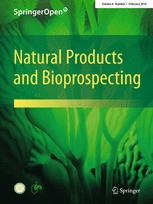|
|
Seven New Drimane-Type Sesquiterpenoids from Cultures of Fungus Phellinus tuberculosus
Collect
Jiang-Bo He, Tao Feng, Shen Zhang, Ze-Jun Dong, Zheng-Hui Li, Hua-Jie Zhu, Ji-Kai Liu
Natural Products and Bioprospecting. 2014, 4 (1): 21-25.
DOI: 10.1007/s13659-014-0002-x
Seven new drimane-type sesquiterpennoids, phellinuins A-G(1-7), together with one known compound 3β, 11, 12-trihydroxydrimene(8) were isolated from the cultures of mushroom Phellinus tuberculosus. Their structures were elucidated on the basis of NMR and MS spectroscopic data and by comparison with data reported in the literature.
References |
Related Articles |
Metrics
|
|
|
Morphological Effects of Natural Products on Schizosaccharomyces pombe Measured by Imaging Flow Cytometry
Collect
Joel Heisler, Lindsay Elvir, Farah Barnouti, Erica Charles, Tom D. Wolkow, Radha Pyati
Natural Products and Bioprospecting. 2014, 4 (1): 27-35.
DOI: 10.1007/s13659-014-0004-8
Gaining a full understanding of the mechanisms of action of natural products as therapeutic agents includes observing the effects of natural products on cellular morphology, because abnormal cellular morphology is an important aspect of cellular transformations that occur as part of disease states. In this study a set of natural products was examined in search of small molecules that influence the cylindrical morphology of fission yeast Schizosaccharomyces pombe. Imaging flow cytometry of large populations of S. pombe exposed to natural products captured cell images and revealed changes in mean length and aspect ratio of cells. Several natural products were found to alter S. pombe's morphology relative to control, in terms of elongating cells, shrinking them, or making them more round. These results may facilitate future investigations into methods by which cells establish and maintain specific shapes.
References |
Related Articles |
Metrics
|
|
|
New Taxane Diterpenoids from Taxus yunnanensis
Collect
Ping Hai, Shi-Zhen Wen, Yan Li, Yuan Gao, Xian-Jun Jiang, Fei Wang
Natural Products and Bioprospecting. 2014, 4 (1): 47-51.
DOI: 10.1007/s13659-014-0003-9
Three hitherto unknown taxane diterpenoids, namely baccatin VIII(1), baccatin IX(2), and baccatin X(3), along with 10 known analogues were isolated from an ethanolic extract of the twigs and leaves of Taxus yunnanensis. The new structures were characterized based on extensive spectroscopic analysis. Compounds 1 and 2 were tested for their in vitro cytotoxicity against five human tumor cell lines, and 1 exhibited inhibitory effects on HL-60 and MCF-7, with IC50 values of 3.44 and 9.67 μM, respectively.
References |
Related Articles |
Metrics
|
|
|
Diterpenoids and Limonoids from the Leaves and Twigs of Swietenia mahagoni
Collect
Wei-Ming Zhang, Jie-Qing Liu, Yuan-Yuan Deng, Jian-Jun Xia, Zhi-Run Zhang, Zhong-Rong Li, Ming-Hua Qiu
Natural Products and Bioprospecting. 2014, 4 (1): 53-57.
DOI: 10.1007/s13659-014-0006-6
Three new compounds, including two diterpenoids, nemoralisins H and I(1 and 2), and a limonoid, 2-methoxy khayseneganin E(3), along with four known constituents(4-7), were isolated from the leaves and twigs of Swietenia mahagoni. Their chemical structures were elucidated by means of spectroscopic analysis. The cytotoxities of these isolated constituents were assayed.
References |
Related Articles |
Metrics
|
|

